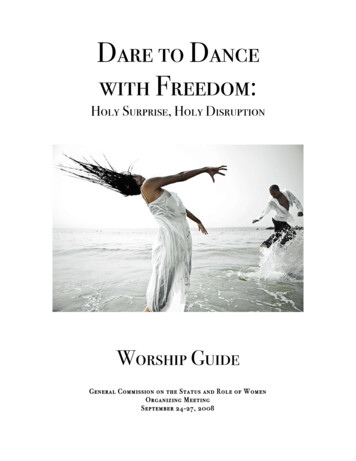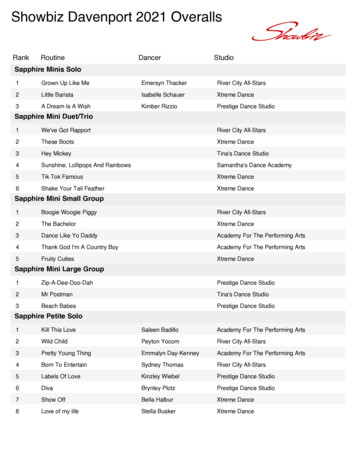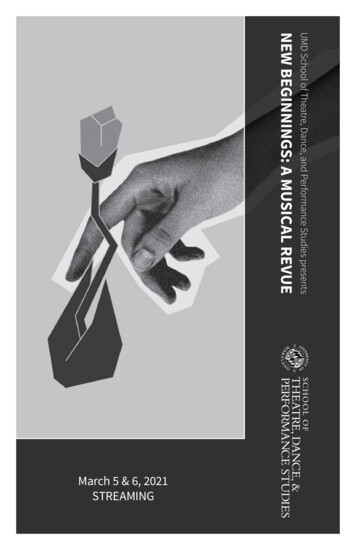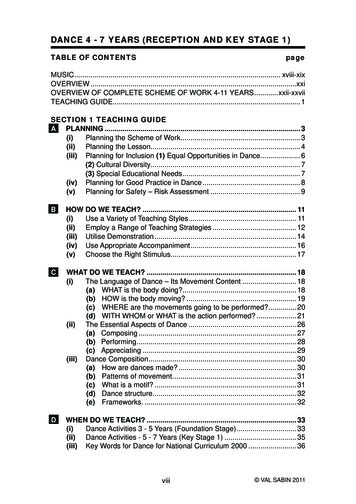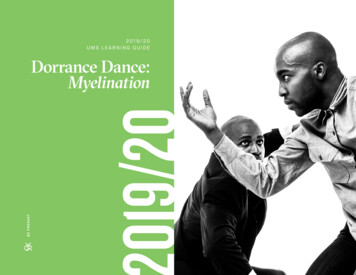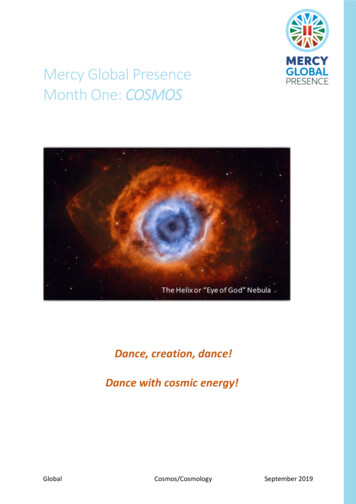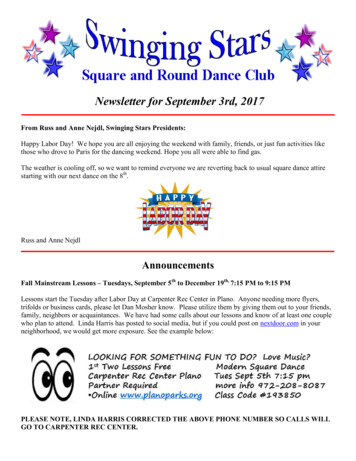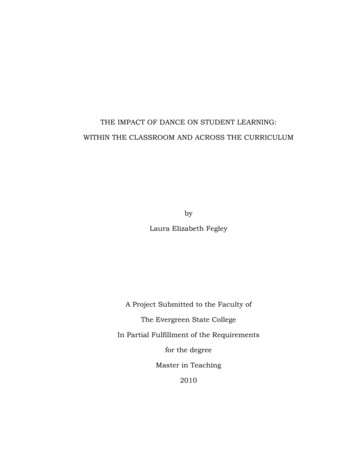
Transcription
THE IMPACT OF DANCE ON STUDENT LEARNING:WITHIN THE CLASSROOM AND ACROSS THE CURRICULUMbyLaura Elizabeth FegleyA Project Submitted to the Faculty ofThe Evergreen State CollegeIn Partial Fulfillment of the Requirementsfor the degreeMaster in Teaching2010
ACKNOWLEDGEMENTSI wish to thank the Evergreen faculty, cohort, my friends, and myfamily, in their support and encouragement in the development of thisresearch. I would like to thank Dr. Jon Davies for his help and advice incleaning up my ideas and grammar. A special thank you to CateyChristiansen for our work sessions, late night phone calls, internetchats, and her research expertise—without which, I would not havefinished this project. Thank you to my sister, Sara, for her thoughts,thesaurus expertise, wisdom, and constant peer-pressure in getting backto my work when I very much wanted to procrastinate. Thank you to mymother and father for putting me through undergraduate school so that Icould continue to further my education. Thank you to my mother forshowing me what an outstanding teacher looks like in the way she raisedme, and in the ways I hear about her as a teacher of other peoples’children. Thank you to my younger sister, Kelsey, for her love andsupport. Finally, thank you to my wonderful husband, Brett, forsupporting and encouraging my decision to go to Evergreen and alwayspushing me to do better in life—without you, this paper would not havebeen possible.iii
ABSTRACTThe purpose of this paper is to examine how dance supports studentlearning within the classroom and across the curriculum. This topic hasthe potential to further the prevalence of dance in public education, andcan guide educators in the way they choose to instruct dance—whetheras its own subject or as an integrative method. The history of danceeducation traces its rises and falls in public education, discussesgovernment and organizational influences, and explains the rise ofnational dance standards. A critical review of the literature has broughtforward four themes in efforts to understand how dance supportsstudent learning, to include: student engagement, critical and creativethinking, self-concept, and dance as part of a more holistic method.Student engagement and critical and creative thinking in dance are mostoften found through constructivist methods of learning. Dance educationcan affect self-concept both positively and negatively based on experiencelevel, competitiveness, and teacher feedback. Utilizing dance as part of amore holistic approach to teaching can create increased motivation andengagement for students. Awareness and use of the findings imply thatteachers can be successful in supporting student learning.iv
TABLE OF CONTENTSTITLE PAGE . . . . . . . . . . . . . . . . . . . . . . . . . . . . . . . . . . . . . . . . . iAPPROVAL PAGE . . . . . . . . . . . . . . . . . . . . . . . . . . . . . . . . . . . . . iiACKNOWLEDGEMENTS . . . . . . . . . . . . . . . . . . . . . . . . . . . . . . . . iiiABSTRACT . . . . . . . . . . . . . . . . . . . . . . . . . . . . . . . . . . . . . . . . . . ivCHAPTER 1: INTRODUCTION . . . . . . . . . . . . . . . . . . . . . . . . . . . . 1Introduction . . . . . . . . . . . . . . . . . . . . . . . . . . . . . . . . . . . . . 1Rationale . . . . . . . . . . . . . . . . . . . . . . . . . . . . . . . . . . . . . . . 2Controversies . . . . . . . . . . . . . . . . . . . . . . . . . . . . . . . . . . . . 4Definitions . . . . . . . . . . . . . . . . . . . . . . . . . . . . . . . . . . . . . . 6Limitations . . . . . . . . . . . . . . . . . . . . . . . . . . . . . . . . . . . . . . 8Summary . . . . . . . . . . . . . . . . . . . . . . . . . . . . . . . . . . . . . . . 9CHAPTER 2: HISTORICAL BACKGROUND . . . . . . . . . . . . . . . . . . . 11Introduction . . . . . . . . . . . . . . . . . . . . . . . . . . . . . . . . . . . . . 11The Rise of Arts Education in Today’s Public Schools . . . . . . 11Dance Education within the United States . . . . . . . . . . . . . . 14Summary . . . . . . . . . . . . . . . . . . . . . . . . . . . . . . . . . . . . . . . 17CHAPTER 3: CRITICAL REVIEW OF THE LITERATURE . . . . . . . . . 19Introduction . . . . . . . . . . . . . . . . . . . . . . . . . . . . . . . . . . . . . 19Engagement . . . . . . . . . . . . . . . . . . . . . . . . . . . . . . . . . . . . . 20Critical Thinking & Creativity . . . . . . . . . . . . . . . . . . . . . . . . 35Self-Concept . . . . . . . . . . . . . . . . . . . . . . . . . . . . . . . . . . . . . 57Dance as Part of a more Holistic Approach . . . . . . . . . . . . . . 79v
Summary . . . . . . . . . . . . . . . . . . . . . . . . . . . . . . . . . . . . . . . 100CHAPTER 4: CONCLUSION . . . . . . . . . . . . . . . . . . . . . . . . . . . . . . 103Introduction . . . . . . . . . . . . . . . . . . . . . . . . . . . . . . . . . . . . . 103Summary of the Findings . . . . . . . . . . . . . . . . . . . . . . . . . . . 105Implications for Teaching . . . . . . . . . . . . . . . . . . . . . . . . . . . 130Suggestions for Further Research . . . . . . . . . . . . . . . . . . . . . 135Conclusion . . . . . . . . . . . . . . . . . . . . . . . . . . . . . . . . . . . . . . 138vi
CHAPTER ONE: INTRODUCTIONThe danger in a narrow and prescriptive approach tolearning and the curriculum is that we will yet again missout on the opportunities to gain insight from what childrenbring to our schools and classrooms. They will remainpersuaded that the thoughts, feelings, ideas and excitementof their inner lives and world are not for sharing withothers—particularly adults. (Sullivan, 1997, pp. 169-170)IntroductionSullivan (1997) pointed out how students are given littleopportunity to share their inner worlds with a narrow curriculum—Ibelieve dance education allows students to share themselves with boththe inside and outside worlds. The purpose of this paper is to examinethe following question: How does dance education support students andtheir learning within the classroom and across the curriculum? First, Iwill provide background into my experiences with dance and education. Iwill speak to the current relevance of this topic in education. Based oncurrent literature, I will then introduce common themes of how dancecan be used to further the idea of interdisciplinary education. Finally, Iwill offer reasons and concessions as to how this topic will develop myown understanding of dance as an interdisciplinary tool. Through1
discussion of the history, current literature, and implications forteaching, I will explore possible answers.RationaleMy intentions with this research are for both personal and publicreasons. I have been a dance student since the age of three. I have beenteaching dance for the last eight years at private studios, as well as for amajor dance team company. I have danced competitively, and I havedanced as a performance artist. Through looking at dance as an art formI have realized the potential it has in providing students with a gatewayto understanding the world and expressing themselves.In my experience, I have only seen one or two public schoolsoffering dance classes in each place I have lived. Dance seems to havebeen overlooked within the public school system. With the lack of jobsavailable for dance educators within public schools, I am forced toquestion why. Why is dance so often overlooked? How can I back up theimportance of dance education to future employers, students, or otherofficials? What are the benefits of dance in supporting students withtheir learning? This last question is the real issue for me. I could list anumber of reasons that I find dance education to be important to studentlearning, but I want to know what the literature is saying about this asevidence to my reasons. Not only will the answers discovered as to howdance supports student learning help me defend dance to others, but it2
will clearly help to inform my practice as a dance educator. Knowing andunderstanding what the benefits (or non-benefits) of dance educationare, will help me better support my dancers.I find this research to be extremely relevant to the professionaldance community surrounding me as well. For one, dance educators arein high competition with each other for careers within public education.Also, dance programs are typically cut due to lack of resources or beinglow on the priorities of school districts. My research question provides anentry point to defend the importance of dance. Not only can danceeducators utilize the information regarding how dance education cansupport student learning, but core curricular teachers can use thisinformation as well. Understanding the research on dance (and other artforms) supporting student learning could have the potential to helpclassroom teachers better support their own students and be a morelikely candidate for dance educator positions.I know I will find literature as to how dance can be unsupportive tostudents. I welcome this research because it will help me to guide thedirection of my teaching. Such answers will help the dance educationworld to be more aware of potential issues that may arise with students.3
ControversiesMany schools do not offer dance as a part of the curriculum. Manyschools will cut dance or other art forms, if funding is low. Other schoolsmay not have teachers with the proper qualifications or will to instructdance (Lawson-Williams, 2007, p. 47). Unfortunately, there is a plethoraof excuses for why dance is not offered in schools. By discussing suchcontroversies we gain a better understanding of the arguments for andagainst dance education within public schooling.There are many reasons why dance may not be offered withinschools. Much of the reasoning has to do with lack of resources, currentlegislation, and little understanding of the benefits of dance education. Ifind all three of the latter reasons to be interrelated. With the presentstate of the economy and due to current legislation (such as the No ChildLeft Behind Act), public education has shifted most of its focus towardstandardized high-stakes testing, with limited resources for studies otherthan math, reading, and writing (Oreck, 2006; Berube, 1999; Risner,2007; Minton, 2007). Even though dance educators often know andrecognize the importance of dance education, much of the public doesnot—not to mention, the benefits of dance are not well researched(Bonbright, 1999; Minton, 2007). Because it is not common knowledge asto how dance supports student learning and standardized testing is heldon such a pedestal, there is little room for the arts in the curriculum4
(Bonbright, 1999; Risner, 2007; Chapman, 2007). Dance and other artforms are often viewed as enrichment courses, not necessary curriculum(Chapman, 2007). Unfortunately, dance is often the lowest on the totempole in comparison with other art forms.With all of these controversies surrounding dance education, hereare some of the arguments I have found for dance in how it supportsstudent learning. Present research shows that dance may be one of themost effective ways to teach other content areas. Whether as part of amore holistic teaching approach, a way to engage and/or enhance criticalthinking, an outlet for artistic expression and creativity (as well asexercise), an influence on self-concept, or as a means for enhancingstudent engagement, dance can not only assist students and teachers inproviding a new gateway for learning, but it can also become a strongattraction for the community outside of school.Dance education has the ability and flexibility to support studentlearning in a progressive fashion. Dance curriculum allows forexploration and awareness of social justice issues, it encourages andenhances critical and creative thinking, and it encourages studentautonomy. According to Giguere (2005), there are five categories dancefalls under: physical, social, emotional, cultural, and historical. If dancecan explore all of these categories, imagine the opportunities forsupportive teaching and multidisciplinary engagement.5
DefinitionsIt is important to define the terminology I will utilize throughoutthis paper so as to keep readers informed as to how I will engage with thethemes I have discovered in the literature. There are five specific themesthat have become evident as answers to my research question: how candance education support student learning in the classroom and acrossthe curriculum in K-12 public education? There are other possiblethemes that could be explored, such as transcendence; however, thesethemes were highlighted in the bulk of my research: studentengagement, critical thinking, creativity, self-concept, and dance as partof a more holistic teaching approach. Here I will explain reasons for howeach topic will be important to my question.Many of the journals I came across pointed to dance furtheringstudent engagement or disengagement with content (whether the contentbe dance or other disciplines). When speaking of engagement ordisengagement, Stinson (2007) defined these terms in one mannerthrough the words ―fun,‖ ―not fun,‖ and ―gratification.‖ Bond & Stinson(2001) spoke to engagement as superordinary experiences, or―experiences that go beyond the ordinary and everyday‖ (p. 55). Bond &Stinson (2001) also compared their definitions to other researchers‘definitions of what is to be called engagement for the purposes of thispaper. These other researchers‘ terminologies can be found in Chapter6
Three. It is important to acknowledge that hopes for this researchinclude engagement in dance crossing over being engaged with dance asits own discipline, as well as being engaged with dance for the purposesof interdisciplinary use.Dance has been shown to increase critical and creative thinkingabilities. Minton (2003) tested students‘ critical and creative thinking bylooking at their originality, fluency, abstractness, elaboration, andresistance. Keun & Hunt (2006) pointed out in their research on criticaland creative thinking that risk taking leads to originality, and is part ofthe creative cycle.Dance has proven to affect students‘ self-concepts—both positivelyand negatively. When I speak to this research in Chapter Three, my focuswill be more on the positive effects of dance on self-concept; however, Iwill acknowledge potential hazards to self-concept as I find they areworth noticing. Self-concept can be viewed as variables of one‘s self, toinclude: physical self, behavior, family self, self-satisfaction, and socialself (Trujillo, 1981). Vicario et al. (2001) noted that self-concept can berelated to student efficacy, competitive and artistic dance, parentsupport, introversion versus extroversion, as well as potential harms ofdance instruction. Cassady et al. (2004) also related self-concept tostudent confidence levels.7
While I plan to be a teacher of dance, I hope to expand my ownknowledge through collaborations with teachers of other content areas. Ialso find the idea of transfer seductive. If students can utilize the criticalthinking and creativity they learn in dance class and transfer such ideasto math or science, they are reaching for a more holistic (or enriched)method of learning. If science and math students are able to have adance teacher help them learn a more difficult concept in a creative way,they are not only expanding their minds, but gaining a heightenedexperience.The previous four themes prove their worth to the importance ofdance in public schooling. They also explain how dance can be used asan interdisciplinary tool in K-12 education. I will more thoroughlyexplain the current research regarding them in Chapter Three.LimitationsI am well aware that I could point out ways to train teachers to bemore prepared for educating students through the use of dancepedagogy, or that I could discuss the controversies of skepticism of thearts; however, I wish to make a case for the creativity dance implores instudents and how it provides a framework for a more holistic approach toteaching all content areas. Finally, dance is not the end all and be all ofenhancing education. There are many other art forms, as well as8
methods, that can provide opportunities for a more holistic, andconstructivist method of teaching.I choose to focus on dance because I am biased in this researchbased upon my prior knowledge and previous experiences with it. I wishto utilize this research to discover and understand the true benefits ofdance, in order to continue my fight (in a more informed manner) ofkeeping dance in the public school system. With this fight announced, Imust point out that I am more likely to discuss the opportunities dancecan provide than I am to offer concessions regarding the negative effectsof dance.SummaryIn Chapter One I have introduced my research question. I haveexplained my goals and intentions for this paper, defined importantterminology to gain understanding into the themes and ideas of myresearch, and introduced the themes I will be discussing. In Chapter TwoI will provide a historical context regarding dance education in publicschooling. In Chapter Three I will explore the current research regardingmy topic. Chapter Four will cover what this research implies for teachingin the United States.Just as current research is crucial to developing understandingabout using dance as an interdisciplinary tool, so is the historicalbackground. In Chapter Two I will explore historical connections to my9
research question. The content I will explore includes the rise of artseducation in public schooling, dance education within the United States,and history more specific to each theme founded. Here I will provide acontext with which I will be able to more deeply answer my researchquestion in Chapters Three and Four.10
CHAPTER TWO: HISTORICAL BACKGROUNDIntroductionThe process of becoming a dance educator has really engaged mycuriosity regarding how dance education began and how far it has come.In Chapter One I introduced and discussed the controversies related tomy research question: how can dance education support studentlearning within the classroom and across the curriculum. Danceeducation is often overlooked as an important part of the curriculum insupporting student learning due to a lack of resources, lack of researchin regards to the benefits of dance education, and legislation is focusedon other content areas such as math and language arts. Given thisinformation, Chapter Two will help to provide a deeper look into how thecontroversies related to dance education have developed throughouthistory. It outlines the rise of arts education in public schooling andmore specifically dance education within the United States.The Rise of Arts Education in Today‘s Public SchoolsThis section will cover how arts education has risen throughouthistory in the United States public education system. It shows thepatterns of arts education waxing and waning in popularity within publicschooling. This section speaks to a variety of organizations andgovernment legislation that is directly related to interests in artseducation.11
About one hundred ago national public education and mandatoryattendance were on the rise (Riddell, 2000, p. 1). As the educationsystem has grown so has arts education, but not with great ease. Withthe rise of the ideals of progressivism in education led by John Dewey inthe 1930s, arts education began its development. Dewey ―considered theart experience to be the highest form of spiritual and moral experience‖(Berube, 1999, p. 5). One landmark issue that created tension for artseducation, was created in 1957 when the Soviet missile Sputnik waslaunched at the climax of the Cold War, causing a counterrevolutionagainst progressivism to occur. The nation was anxious for a return to―core‖ curriculum and the arts were the first subject matter to be cutfrom schools.Rediscovery of arts education interests was seen starting as earlyas 1963, when the Arts and Humanities Branch of the U.S. Office ofEducation initiated support for the performing arts as curriculum-basedinstruction, to include ―historical perspectives, critical skills, andaesthetic issues‖ (Chapman, 2000, p. 1). In 1965 the Elementary andSecondary Education Act provided money for art programs. According tothe New York Times, ―In 1991 in New York City, an arts-rich community,two-thirds of the public schools had no arts instruction.‖ In the 1997study, the ―American Canvas: An Arts Legacy for Our Communities, by12
the National Endowment for the Arts, concluded that ‗the arts do nothave a secure place in the basic curriculum‖ (Berube, pp. 3-4).Within the last few decades, presidential influence has been placedupon the nation regarding arts education. In 1983, A Nation at Risk: TheImperative for Educational Reform, failed to mention the arts as corecurricula. This was confronted in 1994 with the signed legislation ofGoals 2000: Educate America Act, where Bill Clinton and Congresssigned to include arts in the National Standards Core Curricula within K12 education. As a result, voluntary standards were established withinarts disciplines (Riddell, 2000, p. 2). The standards added to theNational Standards were voluntary standards for teaching the four artdisciplines—dance, music, theatre, and the visual arts. The NationalStandards for Dance Education accomplished numerous things toinclude validating ―dance as a discrete discipline and partner with othercore subjects in education‖ (Bonbright, 1999, p. 2). This may be onereason why some of Clinton‘s budget was aimed at the states‘ artcurricula in hopes that the understanding of the arts, and theirimportant relationship to educational reform, would develop. As Berube(1999) pointed out, ―There is a correlation between the arts and academicachievement in the basic subjects‖ (p. 3).As mentioned here, legislation clearly states that dance and otherarts are their own subjects. Adding standards to the art disciplines13
validates their importance. Why is dance still not available in manyschool systems? Looking at the history of dance and arts education helpseducators understand the slow growth of dance education. The arts helpalong progressive ideals, which clearly concern some politicians andgovernment officials. Bringing it back to the main question—how candance education support student learning in the classroom and acrossthe curriculum—it is more obvious than ever as to the importancebehind the answers to this. The public needs to be informed about thebenefits and support which dance education can provide to students andthe community in order to increase its prevalence within publicschooling.Dance Education within the United StatesThis section of Chapter Two is more specific in focusing on howdance education has risen within the United States. This section willexplore agencies, standards, and gaps within legislation, in order to showwhy it is more important than ever to explore the research question: howcan dance support student learning within the classroom and across thecurriculum? The relationship between the history of dance education andthe research question is crucial to furthering the public understandingand progress of dance education within public schooling.Formal dance education in the United States has been aroundsince 1926, when the first dance major was founded at the University of14
Wisconsin-Madison. University dance programs were mostly associatedwith physical education between then and the 1970s. In 1972, Title IXand the Equal Education Opportunity Act of 1974 lead to dance definingitself as arts related (Bonbright, 1999, p. 1).In 1995 the Arts Education Partnership (AEP), was formulated toserve as a ―catalyst, convener, and collaborator‖ in relations ―with over150 federal and state agencies, arts and education organizations,businesses and corporations, and philanthropic foundations. AEP‘smotto is ‗Good schools require the arts‘‖ (Bonbright, 1999, 3). The AEPassists their partners with accessing government funding to help buildarts education programs through Goals 2000 money. There arenumerous other agencies available to arts education advocates to assistwith access to resources to build arts programs across the United States.This is important because it shows that dance is becoming more andmore relevant in public education.The National Dance Education Association (NDEA) was formed inDecember of 1997 to support the focus of the importance of dance in thehuman experience in education. According to the current executivedirector, Jane M. Bonbright (1999), ―With the aid of federal funding andthe standards movement, dance has emerged as discrete discipline ineducation that is aligned with the arts and considered important to core15
curricula. The National Standards in Arts Education has been adopted oradapted in almost all fifty states across America‖ (p. 2).Even though the Standards have been adopted and dance isbecoming more relevant, there is still a wide gap between the goal of artas core curricula and the actual practice of such. According to Bonbright(1999), ―Arts education in many of the nation‘s 15,000 school districtsremains impoverished or non-existent, and dance education is the leastavailable art form in educational curricula‖ (p. 4). Dance educationissues also worth noting, are the lack of accountability held for teachersregarding the standards, the lack of proper dance facilities in schools,the lack of jobs available, and the lack of properly trained danceeducators. As Doug Risner (2007) noted, ―Legislation alone cannotestablish or provide equal access to dance education in the schools.Although K-12 dance education initiatives during the last decade madeprofound progress, curricular equity and access problems continue to besignificant obstacles‖ (p. 18).In order to address some of these significant obstacles, Risner(2007) suggested many ideas in which dance educators can strive tomake a place for the field of dance. One suggestion made was to:Produce collaborative projects. Like new partnerships, planningand implementing collaborative projects widens dance educators‘lens to include a larger, more common ground and allows for16
greater inclusion. Sharing expertise, resources, and audiences injoint ventures builds an important foundation for the overall statusof dance in the wider community. (p. 20) So while dance educationis slowly progressing towards prominence within the core curriculaof the American education system, there is still work to do.As Bonbright (1999) pointed out, even though dance is makingsubstantial progress in today‘s world, dance education is still the leastrecognized art form within public schooling. As Risner (2007) discussed,it is up to dance educators to progress and make a place for danceeducation within public schooling. These points add to the urgency andnecessity behind understanding how students are supported in theirlearning through dance within a dance classroom or across thecurriculum. By recognizing the benefits of dance publicly, there may bemore opportunity for dance education as core curricula within schools.As dance education becomes more prevalent within schools, the higherthe chance of more substantial support to student learning.SummaryIn Chapters One and Two I have examined the controversies andhistory behind dance education and its impact upon schooling. InChapter Three I will begin to examine the more current literatureregarding dance education and how it can be utilized to support studentlearning within the dance classroom and across the curriculum. In17
Chapter Four I will share what the literature implies for teaching. Inorder to focus my question further, I have come up with a few otherquestions to guide my research: What are the benefits of dance educationto students? What aspects of dance education provide appeal tostudents, teachers, schools, and other community members? In the nextchapter I will critically review the current literature to help answer thesequestions, as well as my main research question: how can danceeducation support student learning within the dance classroom andacross the curriculum?18
CHAPTER THREE: A CRITICAL REVIEW OF THE LITERATUREOutline and RationaleChapter One introduced the research question and thecontroversies surrounding it: how can dance education support studentlearning within the classroom and across the curriculum? Danceeducation is often overlooked as an important part of the curriculum insupporting student learning due to a lack of resources, lack of researchin regards to the benefits of dance education, and legislation is focusedon other content areas such as math and language arts. Not only isdance left out of being its own curricular area, but many teachersoverlook using it within their content areas due to lack of time,resources, or knowledge of how it will help support student learning.Given this information, Chapter Two provided a deeper look intothe history behind these issues. It outlined the rise of arts education inpublic schooling and dance education within the United States. It statedthat arts education saw its demise upon the launching of the Sovietmissile Sputnik, where the United States was anxious to return to ―core‖curriculum and cut the arts. Even though arts education is on the riseagain, research is necessary to explain its importance. Chapter Two alsodiscussed how dance education is beginning to hold equal importance tothat of other art forms. While it has the same acknowledgements fromthe government and legislation, its presence is still missed in numerous19
schools across America. The chapter finally pointed out that it is up todance educators to expose how dance can support student learning inorder to make way for dance educations‘ future within public schooling.Chapter Three will critically review recent literature regarding the ways inwhich dance can positively impact student learning in K-12 education.The research will
thinking, self-concept, and dance as part of a more holistic method. Student engagement and critical and creative thinking in dance are most often found through constructivist methods of learning. Dance education can affect self-concept both positively and negatively based on experience level, competitiveness, and teacher feedback.


